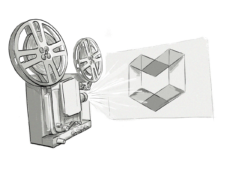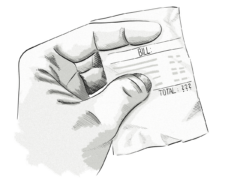Advertising in today’s digital world will never be the same again – thanks to the rise of AdTech.
Like it or not, advertising technology has revolutionized the way brands connect with their audiences and the way advertisers and publishers interact with each other.
Which is why any advertiser or publisher worth their salt should really have a solid understanding of what AdTech is and how it works.
Yes, it’s complicated and yes, it’s in a constant state of flux.
This is AdTech.
But if you need an in-depth look at the most important parts of AdTech, you’ve come to the right place.
AdTech & the Advertiser-Publisher Relationship
Let’s start with the fundamental question: Why do we have AdTech anyway?
What exactly is the purpose of having a complex system of platforms and technology for advertising?
Answering the “why” of AdTech will make it easier to answer the “what” and “how” of it as well.
In a nutshell, advertising technology brings together advertisers and publishers in a way that helps both sides get what they want and need:
Advertisers: successful ad campaigns targeted at high-value audiences
Publishers: ad inventory sold at the best possible price
In essence this has always been the point of advertising and the relationship between the advertiser (demand) side and publisher (supply) side goes back as long as the concept of advertising has existed.

And then the internet came along and changed everything.
Now, instead of an advertiser in Chicago (or the advertiser’s agency) calling up a newspaper and placing an order for a full-page ad in the Sunday edition of the Tribune, that same brand would want to buy ad space on multiple publisher websites and only for site visitors that would be likely to buy their product.
Publishers soon found they had tons of ad space on their hands. At the same time, the number of advertisers wanting to show ads across multiple publishers also increased.
In order to connect the two sides of the advertising equation, there needed to be technical solutions that could handle the enormous number of the advertisers and publishers wanting to do business together.
That’s why there is AdTech. Because it’s needed.
Keeping in mind that all the various elements of the AdTech ecosystem exist to meet the needs of either the advertiser or the publisher, we can better understand what the different platforms are and how they work.
Supply-side (Publisher) Needs
Publishers with ad space to sell want to make money. That’s not hard to understand.
But selling ad inventory in the digital space presents several specific challenges and creates needs which AdTech addresses.
1) Serve ads in real time
Publishers must have a way to quickly and efficiently serve ads every single time there is an opportunity to do so, because every time an app user logs in or a visitor opens a page, a new ad creative can be loaded.
2) Manage (direct) campaigns
Publishers – especially when working in direct relationships with brands – need to be able to quickly implement ads, generate reports, and provide campaign insights to those who advertise with them.
3) Maximize impressions sold
Because the internet made it easy to become a publisher (think bloggers, app developers plus traditional news outlets plus digital-only outlets) the opportunities for buying and selling ads have exploded. This means increased competition and the distinct possibility that some ad impressions may go unsold – especially for non-premium publishers and in non-premium ad slots.
4) Optimizing ad inventory yield
Obviously, publishers don’t want to sell their ad space for peanuts. But with such a wide range of advertisers out there, and so many others on the supply side fighting for ad revenue, publishers needed a way to make sure they could get the best price for every ad slot.
5) Gather audience insights
In order to get the highest price for their inventory, publishers also need to know who is coming to their site or using their application, how often, and what kind of behaviour they are demonstrating. Only with insights like this can they attract advertisers willing to pay higher rates for their ad space.
6) Collect and monetize audience data
For publishers, selling ad space isn’t the only way to make money. They can often monetize their audience data by working with data providers and data vendors to sell it to advertisers who want to use it to target potential customers on other sites.
7) Gather data on ads served
Neither publishers nor advertisers are interested in just slapping ads up on a website for the fun of it. They need hard data on the ads they sell – and not just because advertisers demand this. Publishers also want to know which ad networks/SSPs generate the highest yield or which type of ad is most successful and which partners allow them to monetize their data best.
8) Provide a unified, pleasant user experience
Although publishers are anxious to profit from their ad space, they also need to ensure that the process of serving ad doesn’t hinder the overall UX on their site or in their application.
Demand-side (Advertiser) Needs
On the other side of the digital advertising relationship, advertisers (and often the ad agencies they work with) have their own set of needs.
They want to know how many impressions were served, how many were visible and how many lead to conversions, while publishers need to be able to provide them with this information in order to get paid.
1) Serve targeted ad campaigns
Top of the list for advertisers is the need to be able to serve their ads to the people who are most likely to be interested in them. This may vary depending on the type of campaign and its purpose, but more than anything else, advertisers want to be able to reach out to their most valuable customers.
2) Measure campaign success
How will brands know if they are reaching the right people? Only if they have a way to effectively track their campaigns, attribute conversions and measure engagement.
3) Track the customer journey
Because customers interact with different content at different stages of the decision-making process, brands want to know which touchpoints led to a sale, where they need to improve and how they can provide a more unified customer experience. That’s why marketers and advertisers need AdTech to provide accurate data to pinpoint attribution across all the channels they use.
4) Save time and money
Advertising takes a lot of time and a lot of money – so obviously brands are always looking to trim costs and keep from wasting time on sales processes, campaign trafficking and reporting.
5) Protect brand image
In the wide world of digital, there is the real danger that a brand could create a negative impression of itself by being associated with undesirable content on a publisher site. Other than sticking to direct (and often more expensive) deals, advertisers need to be able to control and verify where their ads are being served.
6) Optimize ad spend based on data
Information about campaign success, conversions and revenue all figure into the equation as advertisers measure their ROI or ROAS. When one campaign produces stellar results, a brand wants to know this and be able to push it to an even wider audience. Likewise a less than optimal campaign will need to be changed or eliminated before it gobbles up a ton of money.
How AdTech Processes Meet Demand- and Supply-side Needs
AdTech wouldn’t be anything without the tools that make it work, but before we get into AdTech platforms themselves, we should understand some of the main processes which go with them.
These processes were born out of the needs (both of publishers and advertisers) mentioned above.
1) Programmatic media-buying and -selling: At the heart of the AdTech system is programmatic media-buying (and -selling.) Basically this means an automation of the process whereby publishers sell their inventory and advertisers (or agencies) buy it. Instead of direct contact between two sales people, both sides use a technology platform to place an order, purchase ads as well as select and serve the appropriate creative.
How it helps: Using technology to speed up the process of buying and selling ads helps both sides keep up with the pace of digital interactions. It also makes it possible for advertisers to connect with publishers who aren’t close enough to contact personally. Now a brand in the US can advertise in Brazil without having to call up and place an insertion order.
2) Programmatic Direct (Automated Guaranteed): Two of the main varieties of programmatic media-buying and -selling are programmatic direct and real-time bidding. The first of these provides a way for brands and publishers to buy and sell ads in an automated way but still in a one-to-one relationship.
How it helps: Publishers are glad to make direct deals with brands they trust when it involves premium inventory. They can usually charge a set (often premium) price and they can also get more control over which ads show on their pages – which makes for a better user experience. Both advertisers and publishers benefit by being able to accurately predict their cash flow, because the price (per thousand impressions served) and inventory volume is set in advance.
3) Real-time Bidding (RTB): The other main kind of programmatic advertising involves real-time bidding, in which ad slots are sold on an “on-demand” basis, usually through an ad exchange where different advertisers have access to inventory from different publishers.
How it helps: Real-time bidding originated as a means for publishers to sell their remnant inventory and it continues to offer this advantage. With RTB, publishers have to worry less about leaving impressions unsold and advertisers can be more assured of getting a fair shake since prices are determined by market demand. Real-time bidding also helps publishers monetize their audience data by letting them connect with advertisers who want to target the publisher’s traffic based on that data.
4) Header Bidding: As an improvement to the waterfall auction process used to connect multiple demand sources on the publisher’s site, header bidding eliminates the sequential prioritization of demand sources and gives all advertisers equal chance to “see” the inventory being sold and bid on it.
How it helps: By removing the preferential treatment involved in waterfall auctions, publishers have the opportunity to make sure that they receive all the possible bids for an ad slot and therefore truly get the highest price. Advertisers get an equal chance to reach their target audiences if they are willing to pay the highest price.
5) Cookie-syncing and data exchange: Because advertisers and publishers track their traffic separately (using cookies) the process of cookie-syncing and data exchange allows different AdTech tools to communicate with each other. Without this ability and the data involved, display advertising would be one big guessing game.
How it helps: If cookie-syncing didn’t exist, publishers would have a hard time interesting advertisers in their ad inventory, because advertisers wouldn’t know if the site visitor was worth targeting. Cookie-syncing also helps advertisers optimize their campaign spend by buying only that inventory which will be viewed by valuable potential customers. Being better able to track audience members also helps advertisers attribute sales and conversions and measure campaign success.
How AdTech Platforms Meet the Needs of Advertisers & Publishers
Now that we know what digital advertisers and publishers need from their technical solutions, and how different AdTech processes help meet those needs, we can look at some of the major components of the advertising technology ecosystem.

Ad Server: To place ad creatives on their site publishers can use a first-party ad server (if there is a direct publisher-advertiser relationship) or a third-party server which is used by advertisers to serve and measure campaigns across multiple publishers and sites.
How it helps: Ad servers help automate the process of placing the ad creative in the ad slot that needs to be filled when a visitor loads a publisher’s page in his or her browser. The ad server can also count impressions and in the case of clicks on an ad, redirect a visitor to an ad’s landing page and record the conversion if the visitor decides to perform a certain action on that page. Without ad servers, the whole process of media-buying and selling would have to be done manually by modifying the HTML code of the website.
Supply-Side Platform (SSP): When publishers want to serve their inventory on ad exchanges (to maximize impressions sold) they need a tool to make inventory available for bidding on by DSPs. This tool is an SSP. It helps the publisher set a price floor (minimum price) for its inventory, receive and accept bids and communicate with the DSPs involved. The SSP is also responsible for adding additional information about the visitor (if possible) so that the advertiser can tell if that person is worth targeting.
How it helps: Obviously, an SSP allows the publisher to quickly sell inventory – often non-premium – so that it doesn’t miss out on revenue. The auction process that the SSP plays a part in makes it possible for demand-side technology to make real-time decisions so they can offer the best price and also helps the publisher maximize the value of audience data by matching it with interested advertisers’ campaigns.
Content Delivery Network (CDN): When creatives are served on web pages or in apps they must be loaded quickly and smoothly (all in the time it takes to open the page). A CDN hosts the creatives until the moment the browser receives the ad markup from the advertiser’s ad server and there is a call for a creative.
How it helps: A CDN further enables the process of serving ads in real time, helps pages load faster and help create a better user experience. With the advent of programmatic video ads (with much bigger creative files) the role of a CDN becomes even more important.
Ad Networks: Ad networks (such as Google AdSense or Taboola) bring together ad inventory from a number of publishers and give advertisers a wider range of choices than they would have in a direct, one-on-one relationship with one publisher. Ad networks can support both open auction buying and “guaranteed” media buys.
How it helps:Advertisers gladly make use of ad networks to increase the reach of their campaigns. With the help of media-buying platforms such as a DSP and in conjunction with a DMP for data-driven decisions, advertisers can access an ad network’s inventory and make intelligent choices about what to buy.
Ad Exchange: Ad exchanges are the platform that connect advertisers (with their DSPs) and publishers (with their SSPs) and allow them to make an ad inventory transaction. Exchanges also offer publishers the possibility of setting up private marketplaces for restricted media-selling.
How it helps: Ad exchanges allow publishers to get rid of any remnant inventory while getting the highest possible price. Advertisers can serve targeted, real-time campaigns through ad exchanges taking advantage of the data that SSPs provide about the visitor that will be viewing the ad.
Agency Trade Desk: Ad agencies have a vested interest in using AdTech and many brands rely on their ad agency to manage their campaigns. Agency trade desks buy ad inventory, repackage it and connect their clients with publishers using DSP-like technology.
How it helps: Advertisers who work closely with their ad agencies expect them to be able to help serve targeted campaigns, gather insights and manage their budgets. For brands who don’t want to invest in a DSP or a large in-house team to handle their campaigns, trade desks offer the advantages of stand-alone AdTech tools (with knowledgeable staff who are qualified to run campaigns on them) plus the possibility to connect with premium publishers that might not work directly with the brand itself.
Data Management Platform (DMP): DMPs are becoming a more essential tool for both advertisers and publishers. They combine data from online and offline sources to create specific audience segments for ad targeting, track campaign data, connect with ad exchanges to buy ads and report data on campaign success.
How it helps: A DMP can help a publisher monetize his or her audience data by letting them gather behavioural data about site visitors, segment it and sell the segments through a DSP. Advertisers like a DMP because they can combine 1st-party and 3rd-party data to find out exactly who to target when buying ad space. They can also use it to measure which audience segments perform the best and analyze their customers’ journey.
Demand-Side Platform (DSP): Demand-side platforms are the tool that advertisers use to communicate with ad exchanges and ad networks to bid on ad space. They can integrate and import data about which audiences to target from a DMP as well as information from the supply side about what kind of user the ad is being served to.
How it helps: Advertisers would be blind without a DSP to make intelligent bids on inventory that publishers and networks put up for sale. They wouldn’t know whether their ad spend was worth it or not. Additionally, they might be cut out of the 3rd-party data available through a DSP, meaning that they would have no way to intelligently extend the reach of their campaigns beyond the 1st-party data they possess.
Perhaps most importantly, thanks to a DSP, brands get access to worldwide ad inventory through a single platform. They don’t have to coordinate with AdOp teams from individual publishers and they can manage all their campaigns across a range of channels in one place.
Summary
Yes, AdTech is complicated.
But it is also a vast improvement over what advertisers and publishers used to have before. And as we have seen here, AdTech exists to meet some very specific needs. As those needs change and grow, so will advertising technology.








